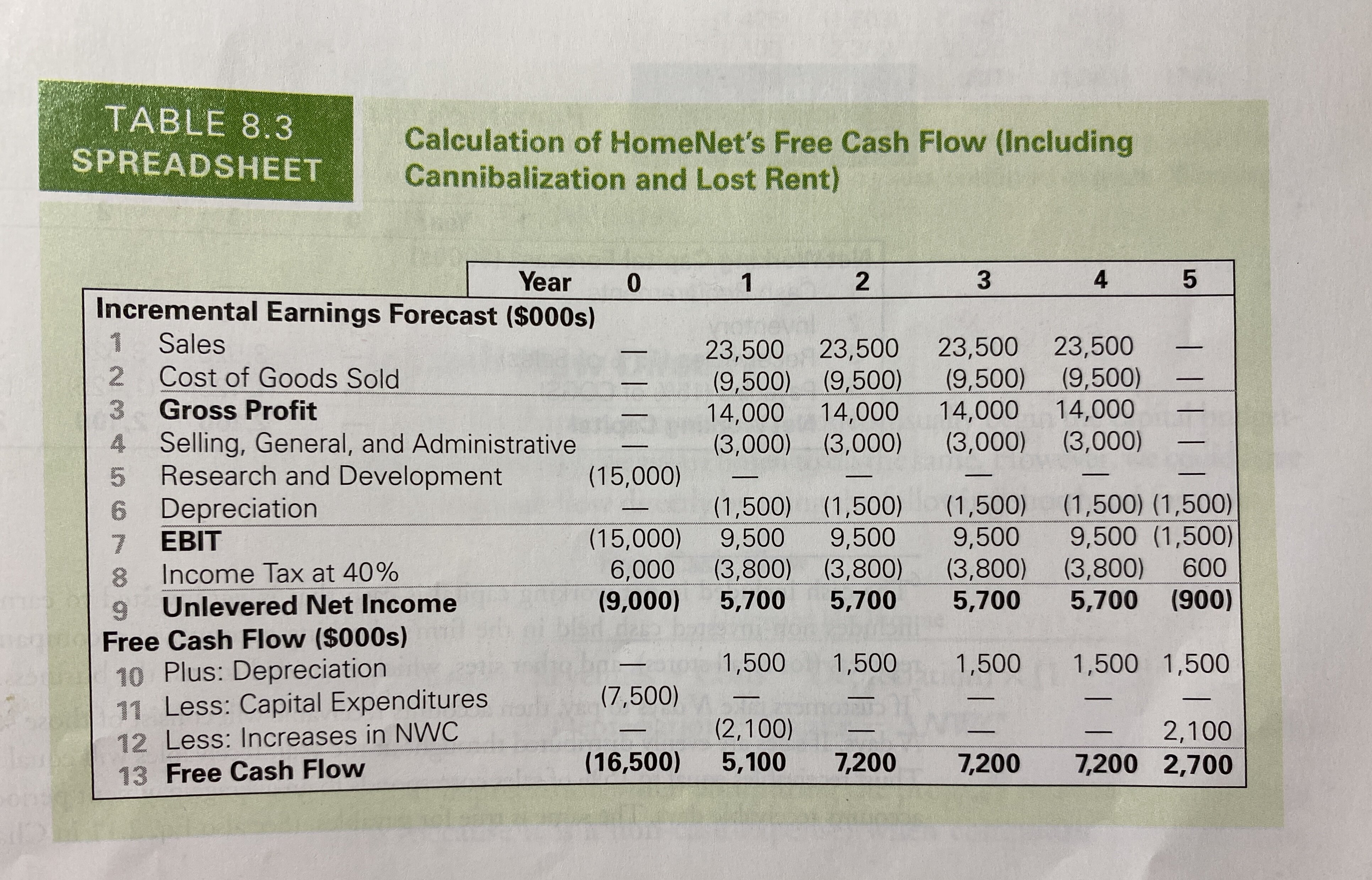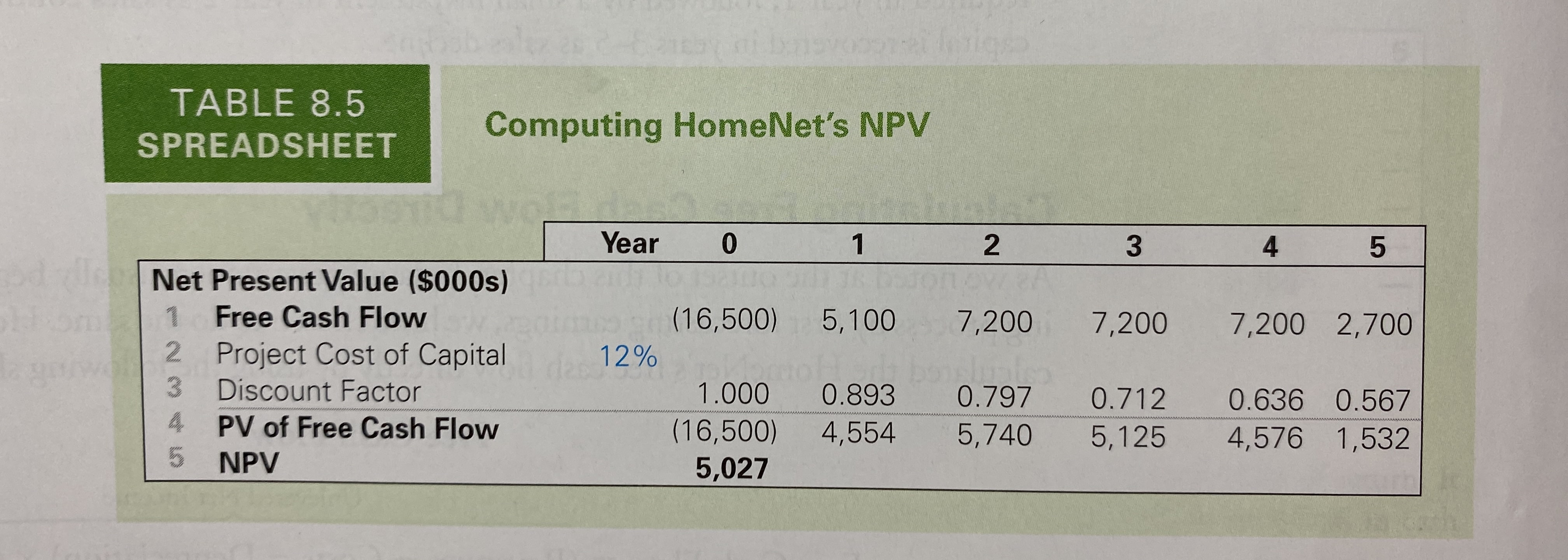Question
Chapter 8 of the textbook (Berk and DeMarzo, 3rd Edition) describes a case study of the Linksys division of Cisco Systems and its evaluation of
Chapter 8 of the textbook (Berk and DeMarzo, 3rd Edition) describes a case study of the Linksys division of Cisco Systems and its evaluation of a wireless home networking appliance, called HomeNet. The division head asks you to refine the project analysis that is summarized in Table 8.3 (Free Cash Flow calculation), Table 8.4 (Net Working Capital calculation) and Table 8.5 (Net Present Value calculation). The analysis should be carried out in a spreadsheet using the format that is discussed in Section 8.2. Regretfully, the original spreadsheet with the project analysis is not accessible because the analyst who built the spreadsheet went on a business trip without storing the file in a shared folder. Therefore, you must build the spreadsheet from scratch based on the screenshots (Table 8.3, 8.4 and 8.5). 1. The original production plan assumes that is possible to outsource the production and packaging at a cost of $110 per unit to the Canadian production company Techbros that was contracted several years ago for a similar project. However, the CEO of Techbros explained today in a ZOOM meeting that this price is not profitable for Techbros due to the high producer price inflation in the past years. The division head of Linksys asks you to compute the EBIT Break-Even Point for the unit costs as well as the highest unit cost level at which the project remains profitable for Linksys. 2. The sensitivity analysis in Table 8.1 does not consider the tax rate. The tax regime may change if US Congress passes a tax reform act or, alternatively, if the profitability of the other projects of the company deviates from the earlier expectations. Perform a sensitivity analysis using a worst-case tax rate of 60% and a best-case tax rate of 20%. Is the decision to accept or reject the project sensitive to the tax rate? Why?
3. The head of Marketing of Linksys believes that consumer adoption of HomeNet can be sped up by employing more salesmen. The total cost of hiring one salesman is estimated to be $150,000 per year. What is the minimal annual growth rate for the sales numbers of HomeNet that would justify hiring 10 more salesmen for the next four years?
4. The original project analysis did not yet account for the use of existing company cars by the salesmen of HomeNet because the analyst did not have a recent valuation of the cars. In the financial statements, you find that the accountants assigned a book value of $250,000 to the cars and they applied straight-line depreciation to zero in the next five years. According to a valuation expert, the current market value is significantly higher than the book value, due to inflation and the good condition and low mileage of the
cars. The valuation expert estimates that the current market value is $500,000 and the estimated residual value in five years from now is $200,000. What is the effect on the NPV calculation of the use of the company cars?
5. (Bonus Question) In a management meeting, an external consultant explains that the HomeNet project has possible strategic value for Linksys. The external consultant considers the HomeNet project to be a platform for future growth by gaining new knowledge, experience, and contacts. He expects that Linksys can start add-on projects that would generate a Free Cash Flow that equals $500,000 next year and that grows at the inflation rate of 2% per annum every year thereafter. The add-on projects would not be available to Linksys if the HomeNet project is canceled, as Linksys would then lose its competitive advantage relative to its competitors. The division head of Linksys is skeptical that we can really predict cash flows of unspecified future projects and he takes the analysis of the consultant with a grain of salt. Still, out of curiosity, he asks you to redo the sensitivity analysis for Units Sold (see Table 8.1) under the assumption that the external consultant is right.


 Calculation of HomeNet's Free Cash Flow (Including Cannibalization and Lost Rent) HomeNet's Net Working Capital Requirements Computing HomeNet's NPV
Calculation of HomeNet's Free Cash Flow (Including Cannibalization and Lost Rent) HomeNet's Net Working Capital Requirements Computing HomeNet's NPV Step by Step Solution
There are 3 Steps involved in it
Step: 1

Get Instant Access to Expert-Tailored Solutions
See step-by-step solutions with expert insights and AI powered tools for academic success
Step: 2

Step: 3

Ace Your Homework with AI
Get the answers you need in no time with our AI-driven, step-by-step assistance
Get Started


